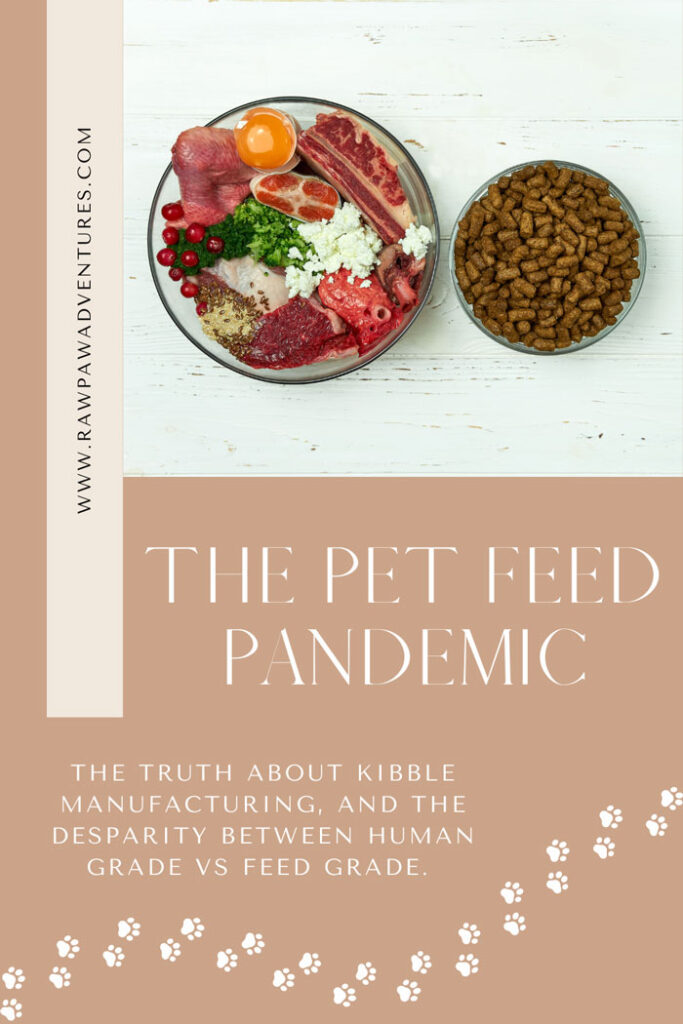Why Bother?
First, because they deserve it. It’s simple, but true. No animal on this planet (including you!) should be eating ultra processed, dehydrating, poor-quality, shelf stable junk for every meal, every day for their entire lives. But beyond the fact that they simply deserve a species appropriate diet, there are some very major health conditions that are directly linked to a kibble diet including:
• Chronic dehydration
• Kidney disease
• Obesity
• Diabetes
• Dental decay and gingivitis
• Leaky gut and chronic GI issues
• UTI’s and urinary crystals, stones and blockages
Humans, cats and dogs are all prone to developing these conditions when we eat a processed diet full of poor-quality ingredients, but the difference is that for (most) people, we at least have the ability to choose for ourselves and tend to eat fresh food frequently, even if we have a junk food problem when it comes to snacks or fast food. Everyone knows that a bag of chips costs less than a fresh salad, but we also know that salad is healthier and therefore we should try to get some greens into our diet. Our pets aren’t given that opportunity in this modern age where convenience and cost lead us to the big bright plastic bags in the grocery stores that are shelf stable and cost effective. However, what you think you’re saving now, your furry family member (and wallet) is paying for later.
Do it right from the beginning.
The best way to get your kitty to eat fresh food is to feed it to them from the moment you bring them home as a kitten. Cats are imprint eaters, which means they decide what is safe and good for them to eat at a very young age, and then don’t deviate from that without significant effort on your part. As kittens, they’re still pretty malleable in terms of developing their palate, and this is the best opportunity to introduce many different textures, flavors and even temperatures to them. Of course, if you had a young kitten who was open to eating anything you put down, you wouldn’t be here right now. So, let’s get into the nitty gritty of how you can get your older kitty onto food that is healthier for them!
Start low and go slow…
This is a phrase we use in medicine, and it holds true when it comes to essentially anything relating to cats. They are naturally suspicious, since this is how they survive in the wild. Those instincts hold true in your home, and they don’t want a big change suddenly, or they can be scared away from trying anything new. The best thing you can do is start with a veeeery small amount of the new food you want to feed and increase it so slowly you’ll almost feel like you’re walking in reverse! And remember that this needs to be a concentrated, dedicated effort to really reach the end game. Here are the steps that I took with my cats, and hopefully you’ll be able to apply some to your cats as well!

1. Switch the kibble to a similarly textured food, such as freeze-dried, dehydrated, or air-dried.
Cats can become addicted not only to the crunch of kibble, but also the taste, because it is sprayed with synthetic flavorings that quite literally cause an addiction that is similar to a person who is addicted to nicotine. I found that air-dried food is the most similar in terms of texture as well as taste.
My three cats needed air-dried before they would accept freeze dried. I used the Chicken & King Salmon air-dried recipe from New Zealand Natural Pet Food Company. They are based out of New Zealand, which has high standards for raising farm animals. Although they do have some synthetics in their formula, the food ingredients are all human grade, and the formula is mostly meat, bone and organ which is species appropriate. I like to call this my ‘gateway food.’
Start by crushing up a small amount of air-dried (or other healthy dry food) and sprinkling it over the top of the kibble. This will allow it to gently mix, and the smell and taste will be lightly mixed in without overpowering the kibble. After doing this for a few days, begin adding a small amount of whole air-dried mixed in with the kibble. Then increase that amount slowly until it’s half and half, then 25/75%, then all air-dried! From there you can repeat that process with a freeze-dried food, which is my top recommendation for a dry food for cats.
2. Switch the canned to gently cooked.
We fed both kibble and canned food in our house before moving to holistic health practices and fresh food. So, while moving away from kibble was tough, moving away from canned had its own challenges. Once again, there are flavorings that make this tough. In addition to that, the texture of canned food is unique and hard to duplicate. I found that a gently cooked premade food was more acceptable to them than switching right to raw. This step took longer to attain than the dry food transition did.
Start out by adding a tiny amount of cooked food to the dish (such as 1/8 or 1/4 tsp), by setting it next to the canned food rather than on top or mixed in. Let them get used to the smell and overall presence of the cooked while still having the option to ignore it if they want. Continue this until you see them showing some interest in it, even if that’s just sniffing it. Slowly move it closer to the canned until it’s touching- this can be done over about a week.
Once your foods are touching, mix them together. As the days go by, slowly increase the gently cooked that is mixed in until you’ve gotten to fully cooked. If at any point your kitty refuses to eat the food, go back to the last mixture you had before increasing the cooked food and try again- you may have just gone too fast.
At this point, if you already have an air-dried or freeze-dried food they like, you can crush and sprinkle this on top to encourage them to eat the cooked food. This is what I still have to do for my oldest cat, Goose, when I feed pork. He wants nothing to do with it until I crush the Green Juju freeze dried salmon bites over the top, and then he goes to town!
3. Transition the cooked food to raw food.
Once your kitty is eating gently cooked, hopefully the transition to raw won’t be too tough. Remember that raw food doesn’t smell as enticing as cooked food does (think of a raw steak on the counter that has minimal smell vs the delicious aroma once you put it on the grill to sear!). Follow the same steps as above for moving to cooked and be sure to be patient and meet your kitty where they are at. Remember that we are asking them to do something they have never done before and it’s scary to try something new!
4. Begin adding moisture to the freeze dried food.
Having moisture in the food is so incredibly important for cats. They don’t absorb water well from simply drinking which increases their risk for developing kidney disease. Rehydrating food is a great way to add hydration to their bodies by putting it back into the food, which is easier for them to absorb as well!
I like to use bone broth to rehydrate freeze dried food, but water will work as well as raw goat milk if your kitty accepts that. Start by adding the smallest splash over the food and increase slowly until you’re able to soak the meal for about 20 minutes prior to feeding. If you use store bought bone broth, be sure to get one that has no onions and no added salt. Otherwise, making your own bone broth is easy and cheap!
You might be asking why you’d even bother trying to feed a freeze-dried food if the plan is to add hydration to it and make it less crunchy- I have a few reasons for that! As I mentioned before, cats are imprint eaters, so we don’t want to get them to switch to tolerating only mushy food and nothing else. Life happens, food supply chains can get interrupted, and sometimes we have emergencies. So, I like to be versatile in what I’m able to feed in case one day I have no choice but to turn to a dry food. Also, I like to use freeze dried food as treats!
A few parting points to remember!
Rotation, rotation, rotation! It is so important to rotate proteins AND rotate brands. It’s ideal to have 4-5 main proteins in the mix (such as turkey, beef, pork, rabbit, duck, salmon, etc.) but also rotate the brands that offer those proteins. Again, sometimes things happen, and you might not be able to get your normal brand. If that occurs, you better have another one in your back pocket that you know your kitty will eat! Likewise, different brands often use difference vegetables or other ingredients in their food, so that’s good for creating diversity in the gut.
Never feed cold food. It causes stagnation in the gut and can result in less optimal digestion over time. I put my cat’s premade food into glass containers, then place the container in a sink full of warm water for about 20 minutes prior to feeding to bring it to room temperature. Don’t microwave- that will cook the food. Other options are to pour warm water or warm bone broth over the food prior to eating.
Be patient. Be understanding. Be kind. Approach this transition with love, dedication, and a positive outlook. It really will affect the way your transition goes, and it’s what your tiny carnivore deserves!



